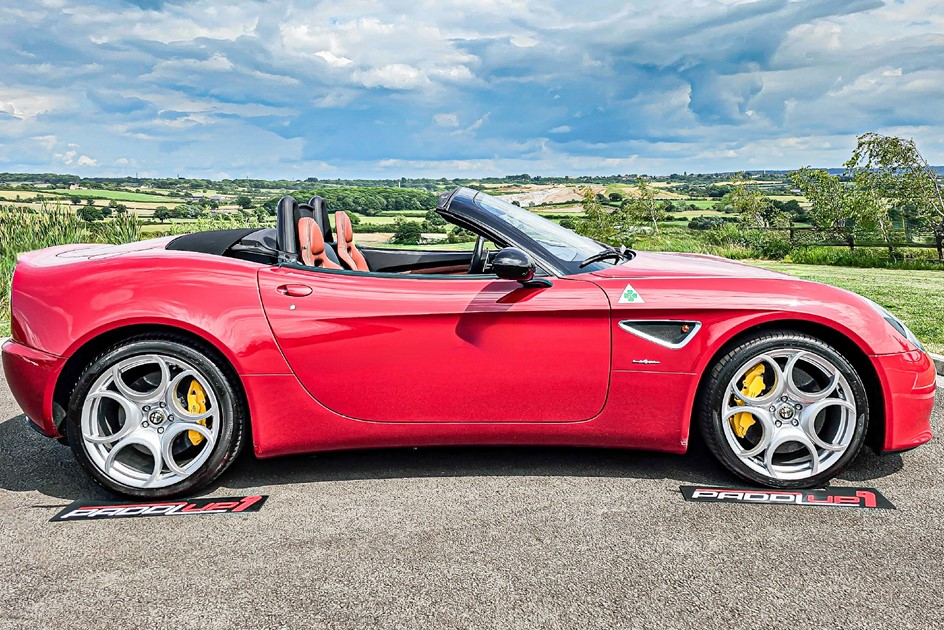Alfa Romeo 8C: the heritage behind the design

The Alfa Romeo 8C Spider encapsulates the heritage of the Milanese brand in a stunning, open-top two-seater grand tourer with nostalgic design lines, a deep V8 soundtrack and resplendent in the historic Alfa Red with four-leaf clover good luck charms adorning the front wings which can be traced back to the racing Alfa Romeo RL of the 1920’s.
Heritage too, influenced the in-house design by the Centro Stile Alfa Romeo, under the leadership of Wolfgang Egger where the lines were mainly inspired by the 1967 33 Stradale and its front-engine rear-wheel drive proportions had a strong essence of the 1963 Giulia TZ, not to mention the name itself, lifted from the 1931 8C which also featured an eight-cylinder engine.
"The car sounds like a growling demon but does it snap like one?"
1923 Alfa Romeo RL
The first Alfa Romeo to don the green-on-white cloverleaf painted directly onto the bodywork was a racing RL Supersport in 1923, with Ugo Sivocci at the wheel. From that moment onwards, the “Quadrifoglio” moniker became a key pillar in the iconic Italian marque's offering.
Designed by Giuseppe Merosi - an engineer for Alfa during that time - the RL was the most capable sports car produced by the Italian brand at the time, and indeed one of the best-performing cars on the market. A 95hp engine, cutting-edge aerodynamics and a lightweight design comprised a recipe for success.
After an extended dry spell for Alfa, Sivocci's good-luck charm cloverleaf proved rather fruitful with wins coming thick and fast following the emblem's introduction at the Targa Florio. When a crash at Monza ended Sivocci's life in 1923, Alfa Romeo decided to pay homage to him by way of the introduction of the Quadrifoglio Verde.
1931 Alfa Romeo 8C
The early 1930s were a prosperous period for Afla, with huge successes for the 6C both on and off the track, it was decided that a new straight-eight cylinder engined car would be produced to help solidify the brand’s reputation of technical excellence. Then, in 1931, Vittorio Jano (head engineer at the time) and his team produced the 8C 2300.
Almost immediately, the 8C began winning the world’s most prestigious races; the first of which was the Targa Florio road races swiftly followed by the Italian Grand Prix in Monza, both within the first 12 months of the car’s lifespan.
The early success of the 8C wasn’t enough though, for Prospero Gianferrari - General Manager at Alfa Romeo - the challenge of the 24 Hours of Le Mans was next on his list to overcome. To comply with the regulations set out by the organisers of the event, a revised 8C 2300 Le Mans, or LM edition was introduced with a long wheelbase and torpedo-esque bodywork. From 1931 to 1934, the 8C went on an unprecedented run of four victories in succession for a single model.
1963 Giulia TZ
The Tubolare Zagato (TZ) was conceived in 1959 to replace the SZ using most of the Giulia series assemblies but with a radical tubular space frame chassis and lightweight Zagato body. These advanced traits made the TZ much more purpose-built for racing than the standard Giulia.
Chief designer Giuseppe Busso said “The TZ1 is the result of the evolution of the concept of a 1500cc racing car that dates back to 1955 that is even before the SZ.” He’s referring to the 750 Competizione which used a steel-boxed chassis which was eventually dropped. Instead, the TZ1 used a more elaborate version of the SZ’s tube frame.
Zagato’s lightweight aluminium bodies were the perfect match for the TZ’s technologically advanced chassis, meanwhile, the introduction of the Kamm Tail proved an aerodynamic breakthrough helping to stabilise the rear without introducing any additional drag. The Giulia TZ1 collected many an accolade during its tenure, including the Sebring 12 Hours, the Targa Florio, the 1000 km Nurburgring and the 24 Hours of Le Mans among other revered road-racing events.
1967 33 Stradale
Following the success of the Giulia TZ and a fruitful return to motorsport for Alfa Romeo, then-CEO Giuseppe Luraghi decided to transform ex-Ferrari engineer Carlo Chiti’s Autodelta outfit - whom he’d earlier commissioned to produce the TZ - into the official Alfa Romeo motorsport outfit. Autodelta followed that up with the Tipo 33, a largely unreliable and uncompetitive machine that proved a brilliant starting point for the 33 Stradale.
Often referred to as one of the first true supercars, the 33 Stradale featured a mid-mounted, 2-litre, 6-speed V8 capable of revving to 10,000rpm, with 227bhp and 152 lb-ft of torque at its disposal. Pair this with an aeronautically inspired bodyshell, designed by Franco Scaglione and facilitated by coachbuilding extraordinaire Carrozzeria Marazzi and you have a car without equal, one that can be likened to a piece of fine art on four wheels.

